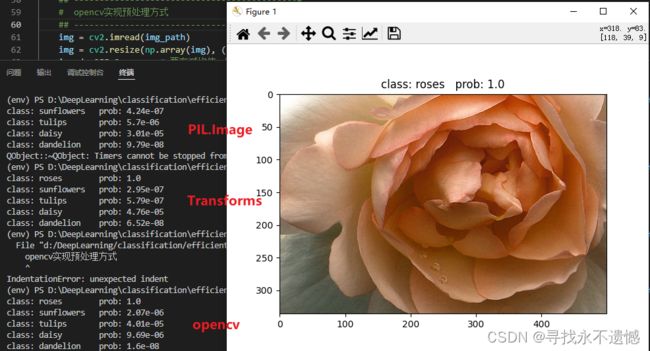【ToTensor() Normalize()替代】不使用torchvision.transforms 对图片预处理python实现
文章目录
- 1 问题介绍
- 2 PIL.Image实现
- 3 python-opencv实现
- 4 整体代码示例
1 问题介绍
在一些场景,无法使用torchvision,自然也无法使用一些集成在transforms里的图像处理操作,在这里记录一下其中部分处理的替代实现。
如下方代码所示,pytorch中常见的图像处理过程有,对图像resize,图像数据归一化,并将数据格式从HWC变为CHW,使用ImageNet数据集预训练的话,还得减去均值,除以方差。
from torchvision import transforms
def main():
data_transform = transforms.Compose(
[transforms.Resize(224),
# ToTensor():数据归一化 + 图像从HWC变为CHW
transforms.ToTensor(),
# 这是Imagenet数据集上,图片 RGB 的均值方差,注意顺序
transforms.Normalize([0.485, 0.456, 0.406], [0.229, 0.224, 0.225])])
2 PIL.Image实现
注意均值方差的通道顺序,上方是RGB,PIL读取的图片也是RGB,故顺序一致。
from PIL import Image
img_path = "./data/rose.jpg"
img = Image.open(img_path)
img = img.convert('RGB')
img_resize = img.resize((224,224), Image.BICUBIC) # PIL.Image类型
# PIL.Image类型无法直接除以255,需要先转成array
img_resize = np.array(img_resize, dtype='float32') / 255.0
img_resize -= [0.485, 0.456, 0.406]
img_resize /= [0.229, 0.224, 0.225]
img_CHW = np.transpose(img_resize, (2, 0, 1))
# 下面这行看着玩即可,上面已经完成了变换
img = torch.unsqueeze(torch.from_numpy(img_CHW), dim=0) # expand batch dimension
...
3 python-opencv实现
注意均值方差的通道顺序,上方是RGB,opencv读取的图片也是BGR,故顺序要变一下。
import cv2
# load image
img_path = "./data/rose.jpg"
img = cv2.imread(img_path)
img = cv2.resize(np.array(img), (224, 224), interpolation=cv2.INTER_CUBIC).astype(np.float32)
img /= 255.0 # 要在减均值,除方差之前
# opencv读的图片,对应的是BGR,均值方差要注意对应
img -= [0.406, 0.456, 0.485]
img /= [0.225, 0.224, 0.229]
# 从HWC,变为CHW
img = img.transpose(2, 0, 1)
# ---------------------------------------#
# 可先转成RGB,再减均值,除方差,但没必要
# ---------------------------------------#
# img = cv2.cvtColor(img, cv2.COLOR_BGR2RGB) # 要是用plt.imshow(img),需要这一步
# img -= [0.485, 0.456, 0.406]
# img /= [0.229, 0.224, 0.225]
# 下面这行看着玩即可,上面已经完成了变换
img = torch.unsqueeze(torch.from_numpy(img), dim=0) # expand batch dimension
...
4 整体代码示例
以Efficientnet-b0在花分类数据集上的预测为例,也就是EfficientNet训练自定义分类数据集中的predict.py。
import os
import json
import cv2
import torch
from PIL import Image
from torchvision import transforms
import matplotlib.pyplot as plt
from model import efficientnet_b0 as create_model
import numpy as np
def main():
device = torch.device("cuda:0" if torch.cuda.is_available() else "cpu")
img_size = {"B0": 224,
"B1": 240,
"B2": 260,
"B3": 300,
"B4": 380,
"B5": 456,
"B6": 528,
"B7": 600}
num_model = "B0"
data_transform = transforms.Compose(
[transforms.Resize(img_size[num_model]),
transforms.CenterCrop(img_size[num_model]),
transforms.ToTensor(), # 数据归一化、图像从HWC变为CHW
transforms.Normalize([0.485, 0.456, 0.406], [0.229, 0.224, 0.225])]) # 这是RGB的均值方差
# load image
img_path = "./data/rose.jpg"
assert os.path.exists(img_path), "file: '{}' dose not exist.".format(img_path)
img = Image.open(img_path)
plt.imshow(img)
## --------------------------------------------#
## PIL.Image实现预处理方式
## --------------------------------------------#
# img = img.convert('RGB')
# img_resize = img.resize((224,224), Image.BICUBIC) # PIL.Image类型
# # PIL.Image类型无法直接除以255,需要先转成array
# img_resize = np.array(img_resize, dtype='float32') / 255.0
# img_resize -= [0.485, 0.456, 0.406]
# img_resize /= [0.229, 0.224, 0.225]
# img_CHW = np.transpose(img_resize, (2, 0, 1))
# img = torch.unsqueeze(torch.from_numpy(img_CHW), dim=0)
## --------------------------------------------#
## torchvision.transforms实现预处理方式
## --------------------------------------------#
# ## [C, H, W]
# img = data_transform(img)
# ## expand batch dimension
# img = torch.unsqueeze(img, dim=0)
## --------------------------------------------#
# opencv实现预处理方式
## --------------------------------------------#
img = cv2.imread(img_path)
img = cv2.resize(np.array(img), (224, 224), interpolation=cv2.INTER_CUBIC).astype(np.float32)
img /= 255.0 # 要在减均值,除方差之前
# opencv读的图片,对应的是BGR,均值方差要注意对应
img -= [0.406, 0.456, 0.485]
img /= [0.225, 0.224, 0.229]
img = img.transpose(2, 0, 1) # 从HWC,变为CHW
img = torch.unsqueeze(torch.from_numpy(img), dim=0)
# read class_indict
json_path = './class_indices.json'
assert os.path.exists(json_path), "file: '{}' dose not exist.".format(json_path)
with open(json_path, "r") as f:
class_indict = json.load(f)
# create model
model = create_model(num_classes=5).to(device)
# load model weights
model_weight_path = "./output/model-25.pth"
model.load_state_dict(torch.load(model_weight_path, map_location=device))
model.eval()
with torch.no_grad():
# predict class
output = torch.squeeze(model(img.to(device))).cpu() # 模型输出,score
predict = torch.softmax(output, dim=0) # 经过softmax转化为概率
predict_cla = torch.argmax(predict).numpy() # 得到最大概率索引
print_res = "class: {} prob: {:.3}".format(class_indict[str(predict_cla)],
predict[predict_cla].numpy())
plt.title(print_res)
for i in range(len(predict)):
print("class: {:10} prob: {:.3}".format(class_indict[str(i)],
predict[i].numpy()))
plt.show()
if __name__ == '__main__':
main()
